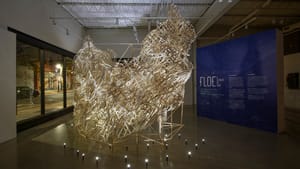Stay in the Loop
BSR publishes on a weekly schedule, with an email newsletter every Wednesday and Thursday morning. There’s no paywall, and subscribing is always free.
Cold, hard fiction
The Museum for Art in Wood presents FLOE: A Climate of Risk

When it comes to climate change, is fiction more persuasive than fact? Stephen Talasnik tests the idea in FLOE: A Climate of Risk, a fable of a ship swallowed by a glacier. The scene of the apocryphal tragedy is now on view at the Museum for Art in Wood.
For those who remain unconvinced of the danger presented by a warming climate—or who are not sufficiently alarmed—Talasnik spins the story of an imagined century-old shipwreck that comes to light only when the glacier that entombed the 19th-century ship melts.
Making tragedy tangible
Unidentifiable fragments begin appearing on Philadelphia’s waterfront and are found by a group of errant schoolboys, one of whom is Talasnik. Debris Fields (1998-ongoing), small sculptures he describes as “fictional archaeology,” fill the gallery. Crafted in basswood, birch, and bamboo, they’re laid out on tables and hung from walls. The skeletal detritus is idiosyncratic and generic, in varied shapes and colors dulled by a watery tomb. They could be anything.
After analysis by University of Pennsylvania archaeologists, the sequence of events emerges. The ship’s last port of call, according to Talasnikian legend, was in Iceland in the late 19th century, where it had sailed after departing Northern Ireland. Upon leaving Iceland, the crew made a fatal error, navigating into a dead end, or “false crevice,” in an ice field. Ship, crew, and cargo were crushed, and the remains were trapped until rising temperatures melted the glacial ice, releasing fragments into the Atlantic Ocean. Currents swept them westward, carrying them into the Delaware Bay and eventually up to Philadelphia.
Predator and victim
The shipwreck is not the only tragedy in Talasnik’s tale. The diminished Glacier (2023) fills the museum’s front window, appearing more billowing trellis than frigid predator. Consisting of bamboo reed strips woven on a pine frame, it seems to be subsiding, evaporating upward on its timbers, like a matron raising her long skirts while crossing a puddle.
Exhibit text provides the science supporting this fiction. Currently, 10 percent of Earth’s land area is covered by glaciers, a tenth of which is accounted for by the Greenland icecap. Antarctica accounts for most of the remainder. According to NASA, whose satellites track the world’s ice sheets, about 270 billion tons of Greenland’s ice melts each year, while Antarctica loses about 150 billion tons. This causes sea levels to rise, alters ocean currents, and contributes to a chain of events fueled by a warming climate.
Downstream effects
Talasnik, a native Philadelphian based in New York, divides his practice between drawing and sculpture, creating works that are both intimate and monolithic in scale. Formally educated as an artist, his work stands at the intersection of art, architecture, and engineering. “Everything begins with the act of drawing,” he has commented. “It is the means to explore visionary landscape and invented organic objects. … The sculptures … start with a single stick or drawn line and organically grow into complex grids or frameworks.”
Earlier in his career, Talasnik spent time in Japan and Southeast Asia, teaching at Temple University Japan and traveling to China, Thailand, and the Philippines. This exposed him to Indigenous building methods and the application of natural materials. Those experiences changed his practice, and their influence pervades FLOE.

Calling himself a “fictional engineer," Talasnik says he neither measures nor uses computer software to create intricate work that appears intensely geometric. Instead, he allows works to do what they will “with a reliance on intuition; there is no desire to finish, rather an ambition to ‘complete.’” As a child, he built scale models of Hershey Park roller coasters from toothpicks and glue and created imaginary realms on paper, noting, “I loved the idea of making, of designing my own world.”
X-rays on ice
Several studio works on view here make plain that Talasnik has been thinking about glaciers for some time. Identified as “visionary glacial architecture,” they include Anatomy of a Glacier (1998-2023), a yawning conch with basswood bones and a shimmering pearl coating, and Fossil and Tunneling (both 2007-2008), peg sculptures mounted in snowy blocks of resin.
Side by side, backlit by sunlight, the pair look like x-rays on ice. Fossil is all knees and elbows, a collision of sharp angles, while Tunneling unfolds calmly in a pleated semicircle.
Capturing the imagination
A selection of works from the permanent collection has been placed in conversation with the exhibit by Talasnik and museum curator Jennifer-Navva Milliken. Located in a corner of the gallery designated The Closet of Curiosities, the permanent works, like the exhibit, evoke themes of nautical architecture, antiquity, and ambiguity. Among them are Mark Lindquist’s Ancient Archaeological Captive (1990-1992), a pecan and verdigris urn with spiraling center and hieroglyphic-style markings, and Katie Hudnall’s Five Stories Cabinet (2022), a wall-mounted tower of found items that’s equal parts birdhouse, carillon, and treasure trove.
Could the tale of a crushed ship and a dying glacier be more persuasive than the daily drumbeat of frightening fact? Perhaps. This much is certain: it’s easier to change hearts and minds by first capturing imaginations.
What, When, Where
FLOE: A Climate of Risk. Through February 18, 2024, at the Museum for Art in Wood, 141 N 3rd Street, Philadelphia. (215) 923-8000 or museumforartinwood.org.
Accessibility
The Museum for Art in Wood is an ADA-compliant facility. Visitors who have questions or need information are invited to contact Katie Sorenson, director of outreach and communications, at [email protected].
Sign up for our newsletter
All of the week's new articles, all in one place. Sign up for the free weekly BSR newsletters, and don't miss a conversation.